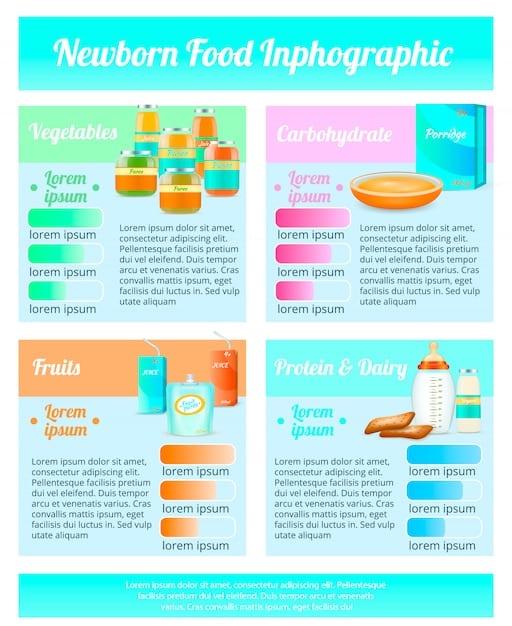Decoding Baby Food Labels: A 2025 Guide for Parents

Decoding baby food labels in 2025 involves understanding updated nutritional guidelines, recognizing key ingredients, and identifying potential allergens to ensure your baby receives safe and healthy food.
Navigating the world of baby food can be overwhelming, especially when trying to decipher the information on those tiny labels. What do all those ingredients mean? How can you be sure you’re choosing the healthiest options for your little one? This is why decoding baby food labels: what you need to know in 2025 is essential, empowering you to make informed decisions for your child’s well-being.
Understanding the Basics of Baby Food Labeling
Baby food labels are designed to provide essential information, but they can often seem confusing. Understanding the basics will empower you to make informed choices when selecting food for your baby. Let’s demystify the key elements so you can confidently navigate the supermarket aisles.
Mandatory Information on Baby Food Labels
Regulations require certain information to be prominently displayed. This ensures parents have access to crucial details at a glance.
- Name of the product: This clearly identifies what the product is, such as “Organic Applesauce” or “Stage 1 Sweet Potatoes.”
- Net weight or volume: Indicates the amount of food contained in the package.
- Ingredient list: Lists all ingredients in descending order by weight.
- Nutrition facts panel: Provides information on calories, fats, carbohydrates, protein, and key vitamins and minerals.
Understanding these basics allows parents to quickly assess the contents and nutritional value of the baby food they are considering.
Decoding Common Terms and Claims
Baby food labels often use terms like “organic,” “natural,” and “non-GMO.” Understanding what these terms really mean can help you make informed choices.
- Organic: Means the ingredients were grown without synthetic pesticides, herbicides, or fertilizers. Look for the USDA organic seal.
- Natural: This term is not strictly regulated, so it can be misleading. It generally implies minimal processing and no artificial additives, but it’s always best to check the ingredient list.
- Non-GMO: Indicates that the ingredients are not genetically modified.
- Gluten-Free: This means the product contains less than 20 parts per million of gluten.
Being aware of these terms and their implications allows you to evaluate the product’s true qualities and benefits.
In summary, knowing the mandatory information and understanding common terms can significantly enhance your ability to decipher baby food labels effectively.
Navigating the Nutritional Information Panel
The nutrition facts panel is a crucial component of baby food labels, but it can also be the most overwhelming. By understanding how to read and interpret this information, you can ensure your baby is getting the nutrients they need. Let’s break down the key components.
Key Nutrients and Their Importance
Knowing which nutrients are essential for your baby’s growth and development is paramount. Here are some key nutrients to look for:
- Protein: Essential for growth and development of tissues.
- Fats: Important for brain development and energy.
- Carbohydrates: Provide energy for daily activities.
- Iron: Crucial for healthy blood and brain development.
These nutrients play pivotal roles in your baby’s health and overall development.
Understanding Serving Sizes and Daily Values
The nutrition facts panel provides information based on a specific serving size. Pay close attention to this, as it may not align with how much your baby actually consumes.
Daily values indicate how much of a nutrient is recommended per day. While these are based on general guidelines, it’s essential to consult with your pediatrician for personalized recommendations.
Being mindful of serving sizes and daily values will help you accurately assess the nutritional content of the food you’re feeding your baby.
Ultimately, understanding the nutritional information panel allows you to make informed decisions about the nutritional value of the baby food you choose for your child.
Ingredient Lists: What to Look For and What to Avoid
The ingredient list is a vital part of the baby food label. By carefully examining the ingredients, you can ensure your baby is getting wholesome foods and avoiding potentially harmful additives. Here’s how to navigate this section effectively.
Prioritizing Whole Foods and Minimally Processed Ingredients
Ideally, baby food should be made from whole, minimally processed ingredients. The fewer ingredients, the better.
Look for foods that list recognizable ingredients like fruits, vegetables, and whole grains as the primary components. These provide essential nutrients without unnecessary additives.
This approach helps ensure your baby receives the most natural and nutritious food possible.
Identifying Potential Allergens and Additives
Recognizing common allergens and additives in baby food is crucial for avoiding allergic reactions and ensuring optimal health.
- Common allergens: Milk, eggs, peanuts, tree nuts, soy, wheat, fish, and shellfish.
- Additives to avoid: Artificial colors, flavors, preservatives, added sugars, and excessive sodium.
Carefully reading the ingredient list can help you steer clear of potential allergens and unnecessary additives that could harm your baby’s health.

The Role of Certifications: Organic, Non-GMO, and More
Certifications on baby food labels can provide additional assurance about the quality and safety of the product. Understanding what these certifications mean can help you make more informed choices.
Understanding the USDA Organic Seal
The USDA Organic seal indicates that the baby food has been produced according to strict organic standards. This means the ingredients were grown without synthetic pesticides, herbicides, or fertilizers.
In addition, organic farming practices promote soil health and biodiversity, contributing to a more sustainable food system.
Choosing products with the USDA Organic seal ensures that your baby is consuming food that meets high quality standards.
What Does Non-GMO Certification Mean?
Non-GMO certification confirms that the ingredients in the baby food are not genetically modified. This is particularly important for parents concerned about the potential long-term effects of GMOs.
The Non-GMO Project Verified seal is the most widely recognized non-GMO certification in North America.
Opting for non-GMO products can provide peace of mind and align with your values regarding food production.
In conclusion, these certifications offer reassurance about the product’s adherence to specific quality and safety standards.
New Labeling Regulations and Updates for 2025
As we look ahead to 2025, new regulations and updates in baby food labeling are expected. Staying informed about these changes can help you navigate the market and choose the best options for your child. The constant evolution of safety and nutrition information means decoding baby food labels will continue to be crucially important for informed parents.
Anticipated Changes in Nutritional Guidelines
Nutritional guidelines for baby food are continuously evolving based on the latest scientific research. In 2025, we anticipate updates in several key areas:
- Added sugars: Stricter regulations on added sugars in baby food to combat early childhood obesity.
- Allergen labeling: Enhanced labeling requirements to ensure clear and prominent allergen information.
- Vitamin and mineral fortification: Potential adjustments to recommended levels of vitamins and minerals to optimize infant health.
Keeping abreast of these changes will enable you to make informed choices that align with the latest nutritional recommendations.
How New Regulations Impact Your Choices
New regulations can significantly impact the types of baby food available and how they are labeled. Be prepared for:
More transparent and detailed ingredient lists, making it easier to identify potential allergens and additives.
Increased availability of organic and non-GMO options, reflecting growing consumer demand for healthier choices.
Potential price increases as manufacturers adapt to meet new regulatory requirements.
These changes will empower parents to make better-informed decisions about their baby’s diet.
Overall, staying informed about upcoming regulatory changes will better equip you to navigate baby food labels and select the best products for your child.
Practical Tips for Making Informed Choices
Decoding baby food labels is not just about understanding the information but also about applying that knowledge to make practical choices. Here are some actionable tips to help you select the best baby food options.
Comparing Different Brands and Products
Comparing different brands and products is essential for making informed choices. Start by:
- Reading the ingredient lists carefully to identify whole foods and avoid unnecessary additives.
- Comparing the nutrition facts panels to assess the levels of key nutrients like protein, fats, and iron.
- Considering the certifications (organic, non-GMO) to align with your values.
This comparison process can help you find the best options for your baby’s specific needs.
Consulting with Pediatricians and Nutritionists
Seeking advice from healthcare professionals can provide personalized guidance based on your baby’s individual needs and health conditions.
Your pediatrician or a registered dietitian can help you interpret baby food labels in the context of your child’s overall diet and development.
This professional guidance can alleviate any uncertainties and ensure your baby receives optimal nutrition.
In summary, use the information and tips provided to make confident and informed decisions regarding your baby’s nutrition.
| Key Point | Brief Description |
|---|---|
| 🌱 Prioritize Whole Foods | Choose products with recognizable ingredients like fruits and vegetables. |
| 🚫 Avoid Additives | Steer clear of artificial colors, flavors, and preservatives. |
| ✅ Check Certifications | Look for USDA Organic and Non-GMO Project Verified seals. |
| 👶 Consult Professionals | Seek advice from pediatricians and nutritionists for personalized guidance. |
Frequently Asked Questions
▼
Organic means the ingredients were grown without synthetic pesticides, herbicides, or fertilizers. Look for the USDA organic seal to ensure compliance with these standards.
▼
Carefully read the ingredient list. Common allergens like milk, eggs, peanuts, tree nuts, soy, wheat, fish, and shellfish must be clearly labeled.
▼
Prioritize protein, fats, carbohydrates, and iron. These nutrients are crucial for your baby’s growth and development.
▼
The term “natural” is not strictly regulated, so it can be misleading. Always check the ingredient list for additives and prioritize whole foods.
▼
Regular consultations with your pediatrician are essential, especially during the introduction of solid foods. They can provide personalized guidance.
Conclusion
By mastering the art of decoding baby food labels: what you need to know in 2025, you can confidently navigate the complexities of infant nutrition. Stay informed, prioritize whole foods, and consult with healthcare professionals to ensure your baby receives the best possible start in life.





